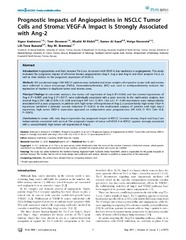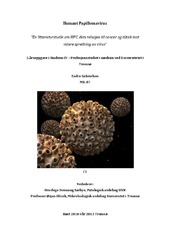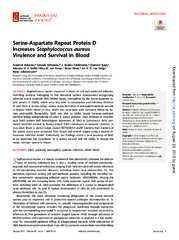Low expression levels of ATM may substitute for CHEK2/TP53 mutations predicting resistance towards anthracycline and mitomycin chemotherapy in breast cancer
Permanent link
https://hdl.handle.net/10037/16454Date
2012-03-15Type
Journal articleTidsskriftartikkel
Peer reviewed
Author
Knappskog, Stian; Chrisanthar, Ranjan; Løkkevik, Erik; Anker, Gun Birgitta; Østenstad, Bjørn; Lundgren, Steinar; Risberg, Terje; Mjaaland, Ingvil; Leirvaag, Beryl; Miletic, Hrvoje; Lønning, Per EysteinAbstract
Methods: We sequenced ATM and assessed gene expression levels in pre-treatment biopsies from 71 locally advanced breast cancers treated in the neoadjuvant setting with doxorubicin monotherapy or mitomycin combined with 5-fluorouracil. Findings were confirmed in a separate patient cohort treated with epirubicin monotherapy. Each tumor was previously analyzed for CHEK2 and TP53 mutation status.
Results: While ATM mutations were not associated with chemo-resistance, low ATM expression levels predicted chemo-resistance among patients with tumors wild-type for TP53 and CHEK2 (P = 0.028). Analyzing the ATM-chk2-p53 cascade, low ATM levels (defined as the lower 5 to 50% percentiles) or mutations inactivating TP53 or CHEK2 robustly predicted anthracycline resistance (P-values varying between 0.001 and 0.027 depending on the percentile used to define "low" ATM levels). These results were confirmed in an independent cohort of 109 patients treated with epirubicin monotherapy. In contrast, ATM-levels were not suppressed in resistant tumors harboring TP53 or CHEK2 mutations (P > 0.5).
Conclusions: Our data indicate loss of function of the ATM-Chk2-p53 cascade to be strongly associated with resistance to anthracycline/mitomycin-containing chemotherapy in breast cancer.
Description
Publisher
BMCCitation
Knappskog, S., Chrisanthar, R., Løkkevik, E., Anker, G., Østenstad, B., Lundgren, S. ... Lønning, P.E. (2012). Low expression levels of ATM may substitute for CHEK2/TP53 mutations predicting resistance towards anthracycline and mitomycin chemotherapy in breast cancer. Breast Cancer Research, 14:R47. https://doi.org/10.1186/bcr3147Metadata
Show full item recordCollections
Related items
Showing items related by title, author, creator and subject.
-
Prognostic Impacts of Angiopoietins in NSCLC Tumor Cells and Stroma : VEGF-A Impact Is Strongly Associated with Ang-2
Andersen, Sigve; Dønnem, Tom; Al-Shibli, Khalid Ibrahim; Al-Saad, Samer; Stenvold, Helge; Busund, Lill-Tove; Bremnes, Roy M. (Journal article; Tidsskriftartikkel; Peer reviewed, 2011)Angiopoietins and their receptor Tie-2 are, in concert with VEGF-A, key mediators in angiogenesis. This study evaluates the prognostic impact of all known human angiopoietins (Ang-1, Ang-2 and Ang-4) and their receptor Tie-2, as well as their relation to the prognostic expression of VEGF-A. 335 unselected stage I-IIIA NSCLC-patients were included and tissue samples of respective tumor cells and ... -
Humant papillomavirus : en litteraturstudie om HPV, dets relasjon til cancer og tiltak mot videre spredning av virus
Gabrielsen, Endre (Master thesis; Mastergradsoppgave, 2012-06-01)I 1983 oppdaget zur Hausen sammenhengen mellom Humant Papillomavirus (HPV) og livmorhalskreft. På denne tiden visste man ikke at det var HPV som var årsaken til at Helaceller kunne leve in vitro. Ny forskning relaterer HPV til en rekke andre cancertyper. En stor andel anal-, oropharyngeal-, penis-, vaginal-, og vulvacancer skyldes HPV. Det er også påvist HPV i tumorvev fra øsofagus, larynx, lunge, ... -
Determinants of Staphylococcus aureus Colonization and Infection. “Exploring the Role of Cell Wall Anchored Proteins in Adhesion and Immune Evasion”
Ajayi, Clement (Doctoral thesis; Doktorgradsavhandling, 2018-11-09)Staphylococcus aureus is an efficient human colonizer and pathogen. S.aureus' ability to colonize and/or cause infections in humans is due to its expression of many virulence factors. These virulence factors aid the bacterium in adhering, invading and evading the host´s immune defences. This study focused on exploring the role of two cell wall anchored proteins: Serine-aspartate containing protein ...


 English
English norsk
norsk


